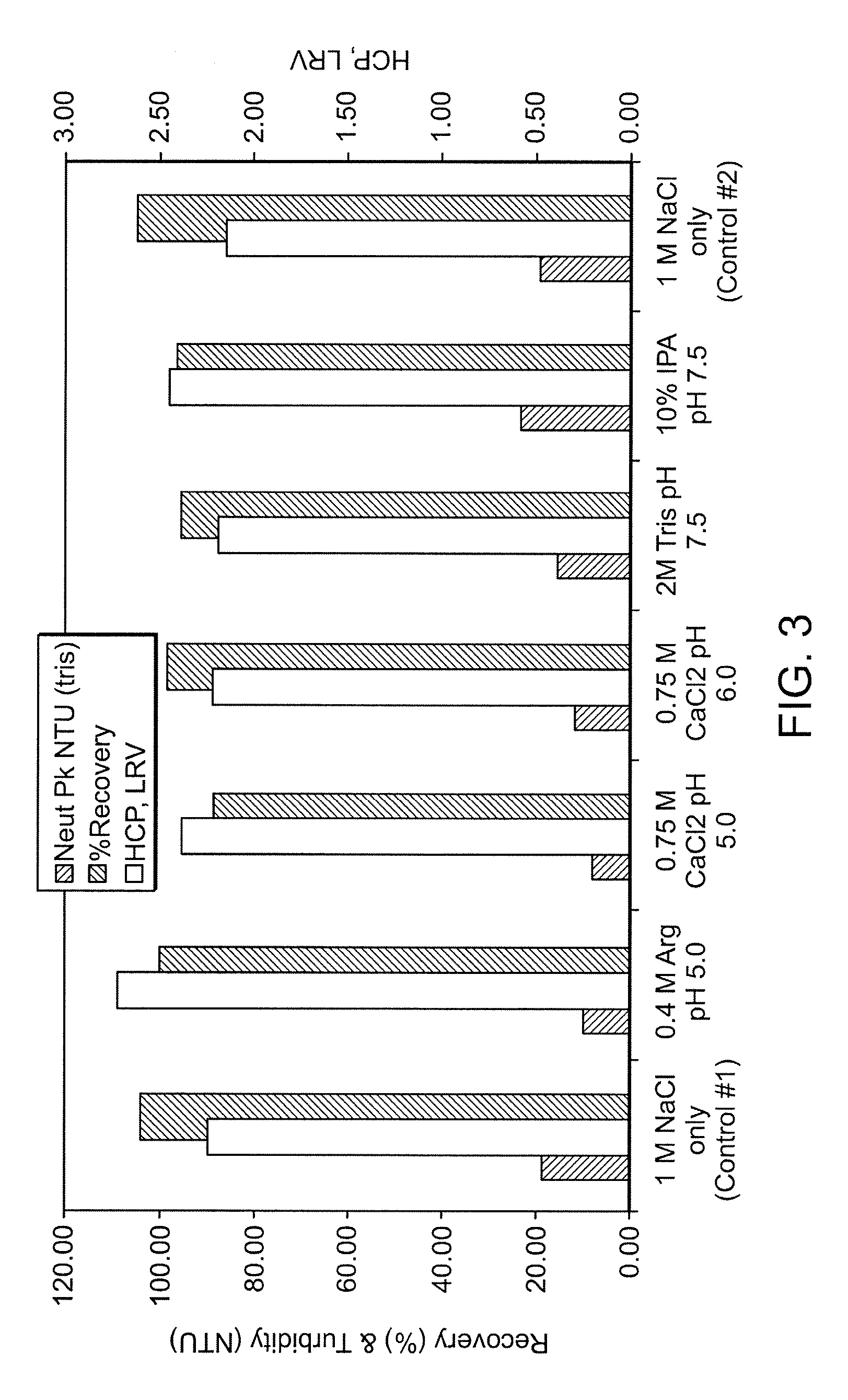Arginine derivative wash in protein purification using affinity chromatography
a technology of affinity chromatography and arginine derivatives, which is applied in the field of protein purification, can solve the problems of significant product loss and contamination of eluted protein products, and achieve the effects of reducing turbidity of eluate, and increasing the ratio of antibody to host cell protein in elua
- Summary
- Abstract
- Description
- Claims
- Application Information
AI Technical Summary
Benefits of technology
Problems solved by technology
Method used
Image
Examples
example 1
GDF-8 mAb-1
Comparison of Protein A Wash Buffers for HCP and Turbidity Reduction and Product Recovery
[0088]The evaluation of various wash solutions was first performed using a high throughput screening (HTS) method. A MabSelect™ Protein A column was initially loaded with conditioned culture media from a Chinese Hamster Ovary (“CHO”) cell culture process. The MabSelect™ resin was then slurried and 100 μL of the resin slurry was dispensed into each well of a 96-well microtiter plate. Each well of the microtiter plate was then washed with a test solution under evaluation, and subsequently eluted with a low pH buffer. The elution pool from each well was assayed for peak turbidity by A320 and for product recovery by A280. Based on the results from the HTS experiments, test solutions that produced the highest recovery and lowest turbidity were selected for further testing using small-scale column scouting runs. In the column scouting runs, a MabSelect Protein A column was equilibrated with...
example 2
GDF-8 mAb-2
Comparison of Protein A Wash Buffers for HCP and Turbidity Reduction and Product Recovery
[0093]The conditioned culture medium from a CHO cell culture process containing GDF-8 mAb-2 was purified at small scale using a MabSelect™ Protein A column. Column sizes used for initial evaluation were 0.5 cm or 1.1 cm in diameter with bed heights from 8 cm to 25 cm. The Protein A operating conditions used for GDF-8 mAB-2 purification, as well as the wash solutions evaluated for HCP and peak pool turbidity reduction were the same as those used in Example 1 (refer to Table 2 for the test solutions evaluated).
[0094]Severe precipitation and product loss was observed in the Protein A elution pool when the control 1M NaCl wash solution was used (FIG. 2). In addition, the HCP clearance across the Protein A column step was less than 1 log10. Compared to alternate wash solutions such as 10% isopropanol, 0.5 M Guanidine-HCl (GuHCl), or 2 M Tris-HCl, an arginine wash was more effective in remo...
example 3
IL-13 mAb-1
Comparison of Protein A Wash Buffers for HCP and Turbidity Reduction and Product Recovery
[0095]The evaluation of several wash solutions for turbidity and HCP reduction across the Protein A column step was initially performed using a high throughput screening (HTS) method. A 25 mL column was packed with MabSelect™ resin and loaded with CHO cell conditioned culture media to a final load challenge of 25 mg of IL-13 mAb-1 per mL of resin. The resin was then slurried and 100 μL of the resin slurry was dispensed into each well of a 96-well microtiter plate. Each well of the microtiter plate was then washed with the test solution under evaluation, and the bound product was eluted with 50 mM glycine, 35 mM NaCl, pH 3.0. Table 3 lists all wash solutions evaluated in this study. The elution pool from each well was measured by A320 for peak turbidity and A280 for product recovery.
[0096]
TABLE 3Wash solutions evaluated in HTS Screen#1Wash SolutionpHConcentrationNaCl - Control7.50.15-3...
PUM
| Property | Measurement | Unit |
|---|---|---|
| pH | aaaaa | aaaaa |
| diameter | aaaaa | aaaaa |
| diameter | aaaaa | aaaaa |
Abstract
Description
Claims
Application Information
 Login to View More
Login to View More - R&D
- Intellectual Property
- Life Sciences
- Materials
- Tech Scout
- Unparalleled Data Quality
- Higher Quality Content
- 60% Fewer Hallucinations
Browse by: Latest US Patents, China's latest patents, Technical Efficacy Thesaurus, Application Domain, Technology Topic, Popular Technical Reports.
© 2025 PatSnap. All rights reserved.Legal|Privacy policy|Modern Slavery Act Transparency Statement|Sitemap|About US| Contact US: help@patsnap.com



